#humidity monitoring devices
Explore tagged Tumblr posts
Text
#motion sensors and detectors#humidity sensors#temperature and humidity sensor#humidity monitoring devices#wireless sensors#smart building sensors#smart sensor
0 notes
Text
Exploring the Benefits of SwitchBot's Thermo Hygrometer for Your Smart Home
Hello everyone! I'm excited to share my thoughts on the amazing innovations in the smart home industry, particularly focusing on SwitchBot's thermo hygrometer. This fantastic device has truly transformed the way I monitor and maintain the comfort of my home.
The SwitchBot thermo hygrometer is not only stylish but also incredibly functional. It accurately measures temperature and humidity levels, allowing you to create the perfect environment for your living space. With its easy-to-read display and user-friendly app integration, you can keep track of your home's climate right from your smartphone.
One of the best features is the ability to set alerts. You can receive notifications if the temperature or humidity goes beyond your preferred range, ensuring that you are always aware of your environment. This is especially helpful for those with specific needs, such as maintaining a comfortable atmosphere for plants or sensitive electronics.
Moreover, the SwitchBot thermo hygrometer is designed to integrate seamlessly with other smart home devices. This means you can automate your heating or cooling systems based on the readings, leading to improved energy efficiency and comfort.
If you're looking to enhance your smart home experience, I highly recommend checking out the SwitchBot thermo hygrometer. It's a great investment for anyone who values a comfortable and well-maintained living space. Happy smart homing!
0 notes
Text

Exploring the Testo 174T Miniature Temperature Data Logger
Discover the features of the Testo 174T Temperature Data Logger, a compact and reliable solution for monitoring temperature-sensitive environments. This miniature temperature data logger is perfect for tracking and recording temperature fluctuations in storage, transport, or process monitoring. With easy-to-use software and robust build quality, the Testo 174T ensures accurate data collection for your critical operations. Visit Shop Testo for detailed specifications and compatibility options to meet your needs.
0 notes
Text
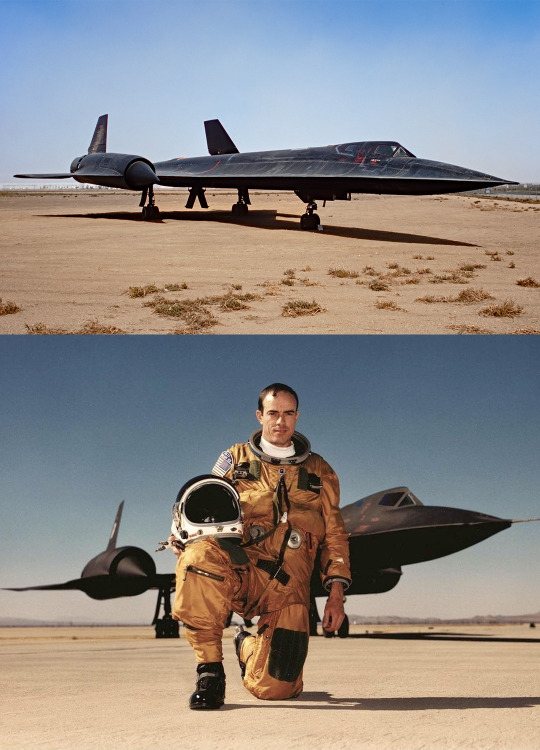
How did pilots of the SR-71 Blackbird prevent the aircraft from leaving contrails over 65,000 feet?
The SR-71 Blackbird was designed to fly at Mach 3.2, or more than three times the speed of sound, and at altitudes up to 85,000 feet. At such extreme conditions, the air temperature was very low, around -60°C, and the air pressure was very low, around 0.9 psi. This meant that the air was very dry and could not hold much water vapor.
The SR-71 had two powerful Pratt & Whitney J58 engines that used a special fuel called JP-7, which had a very high flash point and low vapor pressure. The fuel was also used as a coolant for the engines and the airframe, which heated up due to aerodynamic friction. The fuel was circulated through heat exchangers and then sprayed into the engines’ afterburners, where it ignited and produced thrust.
The SR-71’s engines had a unique feature called “ejector nozzles”, which allowed them to operate efficiently at both subsonic and supersonic speeds. The nozzles consisted of two concentric rings: an inner ring that could move forward and backward to adjust the exhaust area, and an outer ring that had slots to allow air to enter the exhaust stream. The air entering the slots created a shock wave that increased the pressure and temperature of the exhaust gases, making them expand faster and produce more thrust. The air also diluted the exhaust gases, reducing their water content and making them less likely to form contrails.
The SR-71 pilots had to carefully monitor the engine performance and adjust the nozzle position to avoid contrail formation. They also had to avoid flying through clouds or areas of high humidity, which could trigger contrail formation. They used a device called a “contrail light”, which was mounted on the tail of the aircraft and projected a beam of light downward. If the light reflected off a contrail, the pilots would know they had to change their altitude or speed.
One example of a close encounter with a Soviet fighter occurred on Oct. 6, 1986, when an SR-71 was flying along the coast of Murmansk. The pilot, Ed Yeilding, spotted a long white contrail coming towards him at lower altitude. He realized it was a MiG-31 interceptor, one of the few aircraft that could reach the SR-71’s altitude. He raised his periscope and saw that he was also leaving a contrail behind him. He knew that the MiG-31 pilot could see his contrail as well and might try to fire his missiles at him if he crossed into Soviet airspace. He decided to stick to his planned track and get his pictures while depending on his speed and altitude for survival. The MiG-31 came as close as eight miles before running out of airspeed at 65,000 feet.
If you want to learn more about it, I recommend reading some of these books:
Lockheed Blackbird: Beyond the Secret Missions (Revised Edition) by Paul Crickmore
Sled Driver: Flying the World’s Fastest Jet by Brian Shul
Skunk Works: A Personal Memoir of My Years at Lockheed by Ben Rich
84 notes
·
View notes
Text
Reference saved in our archive (Daily updates!)
The catharsis this study gave me by comparing humidity and UV's effects on aerosol spread: Even if farUV is as good as the three or so small-scale studies claim, just take a look at those whiskers. I like my range of efficacy to have a much smaller confidence interval, plus air filters and humidifiers are cheaper and easier to maintain.
Abstract The COVID-19 pandemic highlighted the role of indoor environments on disease transmission. However, our understanding of how transmission occurred evolved as the pandemic progressed. Enclosed spaces where pathogen-laden aerosols accumulate were strongly linked to increased transmission events. Most classrooms, particulalry in the U.S., do not have any mechanical ventilation systems but do have many people congregating indoors for long periods of time. Here we employ a safe, non-pathogenic surrogate virus, the bacteriophage phi6, to interrogate aerosol transmission in classroom environments that do not have any natural or mechanical ventilation in order to provide baseline understanding of how effectively aerosols facilitate new infections. We measure exposure risk using a modified passive monitoring technique compliant with applicable standards, including ISO 14698–1:2003. We find that virus-laden aerosols establish new infections over all distances tested within minutes and that the time of exposure did not change transmission rate. We further find that relative humidity, but not temperature nor a UV-based disinfection device, significantly lowered transmission rates. Our data suggest that, even without mechanical ventilation, relative humidity remains an inexpensive and highly effective mitigation strategy while UV air treatment may not.
#mask up#public health#wear a mask#pandemic#covid#wear a respirator#covid 19#still coviding#coronavirus#sars cov 2#clean air
31 notes
·
View notes
Text

Stretchable transistors used in wearable devices enable in-sensor edge computing
Organic electrochemical transistors (OECTs) are neuromorphic transistors made of carbon-based materials that combine both electronic and ionic charge carriers. These transistors could be particularly effective solutions for amplifying and switching electronic signals in devices designed to be placed on the human skin, such as smart watches, trackers that monitor physiological signals and other wearable technologies. In contrast with conventional neuromorphic transistors, OECTs could operate reliably in wet or humid environments, which would be highly advantageous for both medical and wearable devices. Despite their potential, most existing OECTs are based on stiff materials, which can reduce the comfort of wearables and thus hinder their large-scale deployment.
Read more.
#Materials Science#Science#Transistors#Computing#Electrochemistry#Electronics#Organic materials#Flexible electronics#Wearable technology
16 notes
·
View notes
Text
Bossware Surveillance Buildings
A case study on technologies for behavioral monitoring and profiling using motion sensors and wireless networking infrastructure inside offices and other facilities"
Wolfie Christl, Cracked Labs, November 2024
This case study is part of the ongoing project “Surveillance and Digital Control at Work” (2023-2024) led by Cracked Labs, which aims to explore how companies use personal data on workers in Europe, together with AlgorithmWatch, Jeremias Prassl (Oxford), UNI Europa and GPA, funded by the Austrian Arbeiterkammer.
Case study “Tracking Indoor Location, Movement and Desk Occupancy in the Workplace” (PDF, 25 pages) Summary
As offices, buildings and other corporate facilities become networked environments, there is a growing desire among employers to exploit data gathered from their existing digital infrastructure or additional sensors for various purposes. Whether intentionally or as a byproduct, this includes personal data about employees, their movements and behaviors.
Technology vendors are promoting solutions that repurpose an organization’s wireless networking infrastructure as a means to monitor and analyze the indoor movements of employees and others within buildings. While GPS technology is too imprecise to track indoor location, Wi-Fi access points that provide internet connectivity for laptops, smartphones, tables and other networked devices can be used to track the location of these devices. Bluetooth, another wireless technology, can also be used to monitor indoor location. This can involve Wi-Fi access points that track Bluetooth-enabled devices, so-called “beacons” that are installed throughout buildings and Bluetooth-enabled badges carried by employees. In addition, employers can utilize badging systems, security cameras and video conferencing technology installed in meeting rooms for behavioral monitoring, or even environmental sensors that record room temperature, humidity and light intensity. Several technology vendors provide systems that use motion sensors installed under desks or in the ceilings of rooms to track room and desk attendance.
This case study explores software systems and technologies that utilize personal data on employees to monitor room and desk occupancy and track employees’ location and movements inside offices and other corporate facilities. It focuses on the potential implications for employees in Europe. To illustrate wider practices, it investigates systems for occupancy monitoring and indoor location tracking offered by Cisco, Juniper, Spacewell, Locatee and other technology vendors, based on an analysis of technical documentation and other publicly available sources. It briefly addresses how workers resisted the installation of motion sensors by their employers. This summary presents an overview of the findings of this case study….
6 notes
·
View notes
Text
Top Environmental Monitoring Instruments: From Air Quality to Weather Tracking
Environmental monitoring is essential for assessing pollution levels, predicting weather patterns, and ensuring compliance with regulatory standards. Industries, research institutions, and government agencies rely on advanced instruments to measure air, water, and soil quality. From air quality monitors to weather stations, these devices provide critical data to protect public health and the environment.
1. Air Quality Monitors
Air quality monitors detect pollutants such as particulate matter (PM2.5 and PM10), volatile organic compounds (VOCs), carbon monoxide (CO), nitrogen oxides (NOx), and sulfur dioxide (SO2). These devices are used in industrial zones, urban areas, and indoor spaces to ensure compliance with environmental regulations and protect human health.
2. Gas Analyzers
Gas analyzers measure the concentration of gases in the atmosphere, making them crucial for industrial safety and emissions monitoring. They detect gases such as oxygen (O2), carbon dioxide (CO2), methane (CH4), and hydrogen sulfide (H2S). Industries use these devices to prevent hazardous leaks and maintain safe working conditions.
3. Automatic Weather Stations
Automatic Weather Stations (AWS) collect real-time meteorological data, including temperature, humidity, wind speed, wind direction, atmospheric pressure, and precipitation levels. These stations are essential for weather forecasting, climate research, and disaster management.
4. Water Quality Monitoring Systems
Water quality monitors analyze parameters like pH, dissolved oxygen (DO), turbidity, conductivity, and pollutant levels in water sources. These instruments are used in industries, municipalities, and environmental research to ensure safe drinking water and prevent water contamination.
5. Noise Level Meters
Noise pollution is a growing concern in urban and industrial areas. Noise level meters measure sound intensity in decibels (dB) to assess noise pollution levels and ensure compliance with regulations in construction sites, factories, and residential areas.
6. Dust Samplers
High-precision dust samplers measure airborne particulate matter, helping industries monitor emissions and improve workplace air quality. These devices are critical for compliance with environmental standards and occupational health regulations.
7. Radiation Detectors
Radiation monitoring instruments measure ionizing radiation levels to ensure safety in nuclear power plants, medical facilities, and research laboratories. They help detect harmful radiation exposure and prevent health hazards.
Conclusion
Environmental monitoring instruments play a vital role in safeguarding public health, industrial safety, and ecological balance. With advanced technology, these devices provide real-time data, enabling industries and governments to take proactive measures against pollution and climate change.
Serrax Technology offers cutting-edge environmental monitoring solutions, including air quality monitors, gas analyzers, weather stations, and more. Contact us today to learn how our instruments can help you maintain regulatory compliance and environmental sustainability.
2 notes
·
View notes
Text
Chapter 2
Warnings: MC almost gets kidnapped, anxiety of large places, MC swearing a lot, teenage hormonal responses
Rating: 14+ THE ONLY STORY ON MY ACCOUNT NOT 18+
Word Count: 1,500+

I’m not an idiot
Gotham City, New Jersey. USA
Robin watched as a plane landed at the Gotham International Airport or the GIA. According to his father’s research, a gang leader who went by the name of King of Spades would be coming home to America from the United Kingdom, where he robbed a series of banks. He caused quite a stir for Batman’s allies in the UK, and the whole team was eager to end his criminal career, along with his gang members.
“Batman, I see the target,” Robin stated, pressing down on the earpiece he wore so those on the comlink could hear him.
“Great job, Robin,” Batman replied. “Now get to the next zone, Red Robin and Nightwing are in the building to monitor the target. Do not engage. We are to follow him to the hideout of the Royal Flush Gang.”
The boy in red and green sighed. “I know, Batman, I’m not an idiot.”
“I was simply reminding you,” Batman pointed out. “There is a break-in at a local retail store, Spoiler and I will handle it,” The man announced before cutting off the conversation.
“You know what would be useful right now?” A voice came through on the intercom.
“What, Nightwing?” Robin asked.
“Oo! Let me guess,” yet another voice exclaimed. “Miss Martian’s mental link?”
“Ding ding ding,” Nightwing replied. “Red Robin is our winner.” Then the man sighed, “I’m missing my old team. Missions like this always remind me of them.”
“Sorry we’re not good enough for you, Grayson,” Robin spat.
“Boys, focus,” Batman’s voice came through on the earpiece. “And no real names, you all know this.”
Robin tutted in frustration. “Yes sir.”
“I can feel your anger from here, Robin,” Nightwing stated, there was a shutter in his voice before he let out a dry laugh. “Shit, I see our target. He is making his way to the far east exit.”
“On it,” Red Robin replied. “I have eyes on him, is Batgirl and Red Hood ready?”
“They are,” Batman answered. “Robin, can you tag his car?”
“That’s easy,” Robin stated. “I was trained since a child for missions much more strenuous than this.”
“Strenuous?” Nightwing asked.
“It’s a synonym for hard,” the younger chuckled. “It’s a bit disappointing you don’t know the word.”
“Ouch, how does that burn feel, Nightwing,” Red Robin chimed with a chuckle.
“I know what strenuous means, I’ m just surprised you know,” Nightwing sighed with defeat.
“I’m not an idiot.”
“I never said you were!”
“I’m heading to the car now,” Robin growled before switching off his Bluetooth device and storming out of the area.
On the other side of the airport, Jade Knutsvig was just stepping off the warm plane and into the humid building full of bodies pushing and pulling to board their flights on time. Her eyes widened as she assessed the large building. In all her years she had never been in an airport as large as GIA. Other than the Mall of America, she had never been in a place this large. She had barely traveled outside of her home state. It was completely foreign to the girl.
After the first wave of shock passed, she found herself sitting on a bench, taking in the glass walls that allowed the pale orange light of the setting sun into the structure. It reminded her of tree sap, and she pulled a piece of crystallized amber from her carry-on. Amber could absorb negative energy, and ever since she was a young girl she was able to rely on the smooth stone to ease her anxieties.
Jade whispered a small prayer to herself. It wasn’t to any god, but it was a cry for the universe to help guide her through the maze of the airport. After a few deep breaths, Jade pulled out her phone to message her sister. As the device turned on she could see the shadow of a man looming over her. Without looking at him she could already feel an untrustworthy energy radiating from his aura.
“Are you lost?” The man questioned. “Where is your mom?”
“I’m by myself,” She swiftly answered. The girl was unfamiliar with the hostilities of larger communities. Jade grew up in the comfort of small towns where everyone knew their neighbors and had their noses in one another's business. Her eyes glanced up at the man, and once she made eye contact with him her stomach dropped.
“My name is Bruce Wayne. You might not know of me, but I’m a bit of a celebrity around here. I saw you got off a fight from Minneapolis. Are you from there?”
“No,” Jade whispered. Where is Eliza she found herself thinking. She flies me all the way out to Gotham only to abandon me in an airport!
Being stuck in her thoughts, Jade missed the moment that the man before her reached for her right forearm. His large hand grasped her body, and a rough pull brought her to her feet.
“Woah, dude,” She exclaimed, trying to tug away from him. Her attempt to escape his friends was useless and it only made him hold tighter. “You don’t know what you’re doing! My sister is waiting for me, she will know I’m missing.”
Pleading wasn’t helping Jade’s case, and the man began to lead Jade into the crowd of the airport. Her bag was left behind on the bench, along with her phone. Panic began to set in. This was nothing like home.
“Help!” Jade screamed, “Help me! Someone!”
The man began to dig his nails into her skin, “shut up,” he growled. He then turned to the crowd the circled them. “Sorry, my daughter is just throwing a fit.”
“Help! Please. I don’t know this man!” The young woman began to recall what her older sister taught her many years ago. “Please! This isn’t my dad!”
“Barbra?” A voice sounded from the crowd, and a man with bright blue eyes and dark hair stepped out. “I’ve been looking everywhere for you.”
Another stranger? Why couldn’t her sister be here to grab her? Yet, this guy seemed a lot better than the man who has dragged her across the airport. “Uh- Hi,” Jade said awkwardly. “I don’t know this man. I think he’s trying to kidnap me.”
The assailant let go of the teen and began to push his way through the crowd. The man who referee to her as Barbara stepped closer. “Hey, let me help you.”
“I’m okay,” Jade snapped. She was anxious, homesick, and had her life flash before her eyes. Overthinking took over her, and her brain visualized each situation that could have come to her if the man hadn’t saved her.
“It's no bother,” The man stated.
“I thank you for your help,” Jade huffed, checking her pockets for anything she might have. The girl found nothing but wanted to gift the man something. She closed her eyes while her right hand was shoved in her hoodie pocket and created a shard of jade stone. She presented it to him, flat in her palm. “Here, a token of my appreciation.”
The man accepted it and opened his mouth as if he was going to comment on it. Before he could another man, closer to Jade’s sister’s age, stood next to him. “Hey, I know you’re trying to play hero but she’s safe. We have things to do.”
The man who saved Jade nodded. “Thank you,” He stated, shaking the piece of jade that was in his hands to signify his gratitude. Jade simply nodded before she ran back to her stuff, surprised to see it had not been stolen by a thief.
The moment she found her phone she called her sister. Her heart was still racing, and then a mix of fear and adrenaline made her legs weak. “Where are you?” Her voice was a whisper, and the moment Eliza replied with: “I’m at the gate c-19. Is that not yours?”
“No,” The girl said, but as the syllables left her mouth so did a sob of fear.
“Hey, what’s wrong? Where are you? I’ll be there as fast as I can.”
“I’m at “ Jade choked down another sob. “I’m at gate C-13. I wanna go home,” The girl cried, trying to hide in her hoodie. “Eliza, a man grabbed me.”
“Oh my god,” Eliza gasped. In the background of the call, Jade could hear Eliza’s pace go from a brisk walk to a run. “I see you,” She replied quickly.
Jade looked around before her eyes met Eliza’s. She felt a wave of warmth wash over her. It wasn’t natural, it was Eliza’s power soothing her. The two finally met, and Jade didn’t have time to hang up the call before Eliza’s arms were around her, her body heat matching the temperature of warmth that was soothed Jade meer seconds before. “I’m so sorry. I’m so sorry,” Eliza repeated.
After the two calmed down, filed a police report with airport security and Gotham PD, and retrieved Jade’s bags, the two began their car ride to their home. Jade fell asleep in traffic, and Eliza pondered if the man trying to kidnap her sister was an omen to get her sister out of Gotham already.
#K&T2-23#kittens and titus#robin#dc comics#raven#teen titans#damian wayne#damian wayne x oc#damian wayne x reader#nightwing#red hood#red robin#robin dc comics#batman#batfamily#batfamilyfanfic
68 notes
·
View notes
Text
Costa Rica Is Saving Forest Ecosystems by Listening to Them - by Geraldine Castro | WIRED - SCIENCE | 25th/02/2025

Monitoring Noises in Eco-Systems Reveals Their Health, Allowing Researchers to Monitor Bio-Diversity Changes, Detect Threats & Asess the Effectiveness of Conservation Strategies.
Photograph: Charlie Fayers/Getty Images
Monica Retamosa was in the middle of changing the batteries of a tape recorder when she heard a bellbird for the first time. Standing on a forest floor, she looked up into the trees, scanning for the source of its metallic and powerful sound, searching for the bird for half an hour to no avail. The bellbird sings from the treetops where it is visible to its peers but invisible to those below. Still, Retamosa smiled: She cares for ecosystems in Costa Rica’s AmistOsa Biological Corridor by listening to them.
In nature, living things use sound for almost everything. They make calls to attract mates, communicate identities, warn of dangers, guide the way, and help in hunting or defense. For decades, researchers have tracked species with recorders in hand, and still do, though increasingly are using remote recording devices too. The study of the sounds organisms make is known as bioacoustics. Retamosa has been doing this work for 10 years. Using bio-acoustic recordings, studies have shown that some birds shout loudly to make themselves heard in cities and that sea turtle hatchlings communicate from the nest to coordinate their hatching. And when bioacoustics is combined with other sounds—those made by humans, as well as the natural sounds of the landscape, such as the crashing of waves in the sea—it is possible to interpret deeper ecological meaning. It becomes possible to monitor changes in biodiversity, detect threats, and measure the effectiveness of conservation strategies. This wider analysis of sound is known as eco-acoustics—and it is exactly the work underway here in Costa Rica.

A three-wattled bellbird (Procnias tricarunculatus) in Costa Rica. Photograph: Juan Carlos Vindas/Getty Images
The development of automated recordings revolutionized bioacoustics and ecoacoustics. Now, research groups can hang sensors that record snippets of the day for months at a time without interfering with wildlife. Retamosa likes this strategy because it’s non-invasive to animals, makes it easier to have ears in large areas and hard-to-reach places, and occasionally helps discover mysterious species.
Although she prefers to monitor ecosystems from a distance, Retamosa still has to go deep into the forest to set up recorders. Visits to the field are fascinating, but never a Sunday stroll. She has hiked miles through mud and branches, along with her colleagues Jimmy Barrantes and Randall Jiménez. They have gone up and down endless slopes. Once, she fell and fractured her ribs. But the work doesn’t end with the installation: they have to go back to change batteries and memory cards. In other countries, they use solar panels and the internet to receive real-time data; in the dark, humid rainforests of Costa Rica, it’s still done by hand.
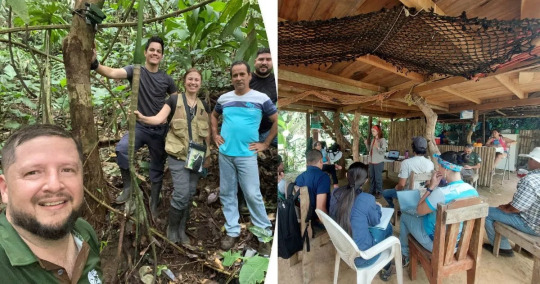
Acoustic-monitoring fieldwork in Costa Rica. Photograph: Courtesy of Jimmy Barrantes & Randall Jiménez.
That’s what Retamosa was doing when she heard the bellbird. That recording forms part of a project to track the movement and distribution of these birds, which migrate between different altitudes in the region. Their presence could be a functional indicator of the state of the AmistOsa Biological Corridor, which connects La Amistad International Park, on the border with Panama, with other reserves in southern Costa Rica.
The biological corridor was shaped by the passage of wildlife that emerged following the 1990 Forestry Law, which protected wilderness areas and encouraged reforestation on farms through payments for environmental services. In 2010, it was officially mapped. Today it runs through indigenous territories and crosses the country’s largest wetland. Across the Costa Rica there are now 53 corridors, covering 38 percent of its territory.
The project data will help the committee in charge of Costa Rica’s biodiversity and natural resources make decisions. “The idea is to make a monitoring protocol, linking the government, the communities, and us as academia, providing support for analysis and interpretation,” Retamosa says.

A Limón giant glass frog in the rain in Braulio Carillo National Park in Costa Rica. Photograph: Christopher Jimenez Nature Photo/Getty Images
Recorders hung in the wild capture many terabytes of data, so listening to every recording is not feasible. With an eye toward making it a cost-efficient strategy, researchers have developed acoustic indices: mathematical formulas to interpret ecosystem traits from the recorded sounds. “They can reflect the acoustic energy of a place, activity, or frequency diversity,” Retamosa explains. When she started in this field, there were only eight acoustic indices. Now there are more than 80.
The discipline is advancing so rapidly that the scope of these indices is currently being debated. In some of her early research, Retamosa found that certain acoustic measurements show variations between tropical and temperate regions. One of the best known, acoustic complexity—the degree of variation and intricate structure of bioacoustic sound—has been used as a descriptor of bird diversity in temperate environments. However, in tropical areas, different investigations have shown that it does not reflect species diversity, but rather the level of acoustic activity; that is, instead of indicating the presence of multiple species, it seems to show the intense vocalization of one or a few birds.
Careful analysis of these indices can be used to reveal the health of the forest. In a report with Jimmy Barrantes, Retamosa outlines that measuring acoustic entropy—the variation of sound intensity across time and audio frequencies—and acoustic diversity helped them to classify the state of disturbance of some sites, while those of acoustic activity and energy did not. “You can use the indices for a first exploration of the site, to do studies over time, looking for specific changes associated with human disturbances and work with key species,” she explains.
Listening for the Impacts of Tourism
Every region has its own environmental concerns. In Costa Rica, tourism has grown dramatically: between 1984 and 1989, international arrivals increased 37 percent, from 273,900 to 375,900 visitors. But since 1990, the pace has skyrocketed: last year the country received 2.6 million tourists. This boom poses sustainability challenges. To address them, the International Institute for Conservation and Wildlife Management team analyzes sounds inside and outside protected areas. One of its tools is an index that measures the ratio between biological sounds and human-made noises.

The acoustic quality of the landscape must be monitored to conserve the country’s ecotourism. Photograph: Jordan Siemens/Getty Images
In recent years, automated acoustic detection, using artificial intelligence and machine learning, has revolutionized species identification. Previously, advanced programming skills were required to use AI, but with the advent of accessible interface models, it’s becoming more popular. Exoacoustics is increasingly focused on developing more accurate models for classifying sounds.
And it’s becoming possible to pick out individual species in the soundscape using these tools. In a study of farms conducted as part of the Bosque Vivo project, run by Costa Rica’s National Forest Financing Fund, the research team found that Hylopezus perspicillatus, a bird species sensitive to landscape disturbance, was only present in the control sites of Corcovado National Park and in the forests of the best-conserved farms.
In Guanacaste, Retamosa is also working on a long-term monitoring protocol to evaluate how ecosystems and biodiversity are responding to climate variability. In other countries, similar projects are recording sound baselines in sites with minimal human intervention that, in the future, could be compared with up-to-date recordings to detect changes. Although storing all these records is costly, Retamosa believes that they’ll form an invaluable historical archive, which one day can be returned to when technology allows further analysis.
This story originally appeared on WIRED en Español and has been translated from Spanish.

2 notes
·
View notes
Text

The 75F Smart Sensors page highlights advanced, IoT-enabled devices designed to monitor and optimize indoor environments. These sensors capture real-time data on temperature, humidity, light, and occupancy, ensuring precise environmental control. Ideal for commercial buildings, they integrate seamlessly with 75F’s intuitive building management systems, enhancing comfort, energy efficiency, and automation. Explore innovative solutions that empower businesses to create smarter, more sustainable spaces effortlessly.
Visit:
#motion sensors and detectors#humidity sensors#temperature and humidity sensor#humidity monitoring devices#wireless sensors#smart building sensors
0 notes
Text
Sleeping Pods for Conscripts
Sleeping Pods for Conscripts
The Sleeping Pods for Conscripts are advanced, integrated rest modules designed for use by military personnel in the Republic's paramilitary forces. These pods are engineered to accommodate conscripts sleeping in their full-body armor, including helmets, providing a seamless, secure, and efficient method of rest and recuperation.
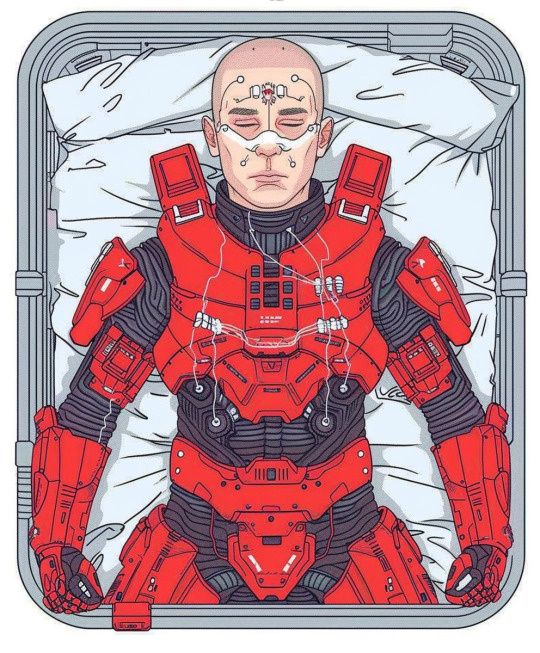
Overview
The sleeping pods represent the pinnacle of military sleep technology, blending comfort with utility to ensure that conscripts remain battle-ready even while at rest. Each pod is constructed from a durable, high-grade composite material that offers protection and insulation, effectively creating a self-contained micro-environment.
Functions and Features
Waste Evacuation System Each pod is equipped with an integrated waste management system that connects directly to the conscripts' armor suits. This system efficiently handles all biological waste, ensuring hygiene and comfort without the need for the conscript to leave the pod.
Power Charging Interface The pods feature a sophisticated power interface that connects to the conscripts' armor suits, ensuring that all electronic systems, including communication devices, HUDs (heads-up displays), and life support systems, are fully charged and operational upon waking.
Life Support Integration The pods are equipped with advanced life support systems that monitor and regulate the conscripts' vital signs, providing real-time data to the central command system. This includes oxygen supply management, temperature control, and emergency medical response capabilities.
Hydration System To maintain optimal hydration levels, the pods are fitted with a hydration system that supplies water directly to the conscripts' armor suits. This system ensures that conscripts remain hydrated throughout their rest period without needing to remove their helmets.
Sensory Deprivation and Noise Cancellation To ensure optimal rest, the pods utilize state-of-the-art sensory deprivation technology, including noise-canceling mechanisms and adjustable ambient lighting. This creates a tranquil environment, free from external disturbances.
Communications Link Each pod maintains a secure communication link with central command, allowing for instant alert and mobilization if necessary. This link also enables conscripts to receive updates and briefings without leaving their pods.
Ergonomic Design Despite the full armor requirement, the pods are ergonomically designed to offer maximum comfort. Adjustable internal padding and support structures conform to the contours of the armor, reducing pressure points and ensuring a restful sleep.
Quick Egress System In the event of an emergency, the pods are equipped with a rapid egress system that allows conscripts to exit and mobilize within seconds. This system is synchronized with the conscripts' armor to ensure immediate readiness.
Environmental Conditioning The pods maintain a controlled internal climate, adjusting temperature and humidity to optimal levels for rest. This conditioning also includes air filtration systems to remove contaminants and ensure a clean breathing environment.
Hot Bunking Capability Designed for efficiency, the pods support hot bunking, allowing multiple conscripts to use the same pod in shifts. The pod’s systems quickly sanitize and reset between uses, ensuring each conscript has a clean and ready environment.

Operational Benefits
The integration of sleeping pods into the conscripts' daily routine offers several operational advantages:
Enhanced Readiness: Conscripts remain in their armor and can be deployed instantly, reducing response times during critical situations.
Improved Health Monitoring: Continuous vital sign monitoring ensures early detection of health issues, allowing for prompt medical intervention.
Increased Efficiency: By managing waste, hydration, and charging needs within the pod, conscripts can maximize their rest periods, leading to improved performance during active duty.
Resource Optimization: Hot bunking capability allows for efficient use of space and resources, accommodating more conscripts with fewer pods.
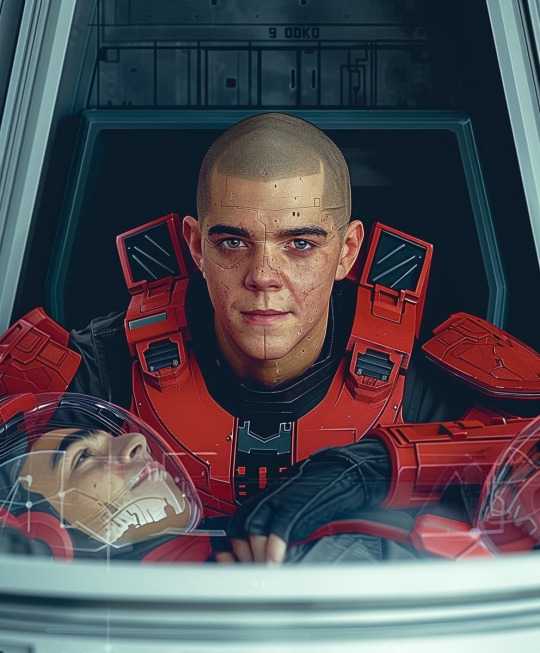
Usage
The sleeping pods are deployed in all major barracks and outposts within the Republic's territory. They are a standard feature in the accommodation of Enforcer Cadets, Paramedic Corps members, Lifeguards, and other paramilitary units. Each pod is assigned to an individual conscript and is programmed to recognize and interface exclusively with their specific armor suit.
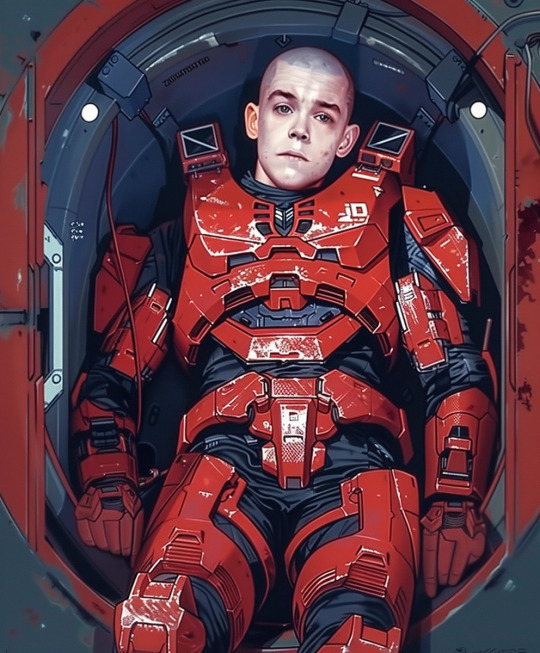
See Also
Armor Suits of the Republic
Neuro-Based VR Training Modules
Life Support Systems

References
Republic Defense Technologies Manual, 2047 Edition
Advanced Military Rest Systems: Enhancing Soldier Efficiency and Readiness by Dr. V. Harkness
The Integration of Technology in Modern Warfare by Prof. K. Linwood
This article is part of the Republic's Military Technology Series, providing detailed information on the advanced systems used to maintain the security and efficiency of our paramilitary forces. For more articles, visit the Republic Military Archive.
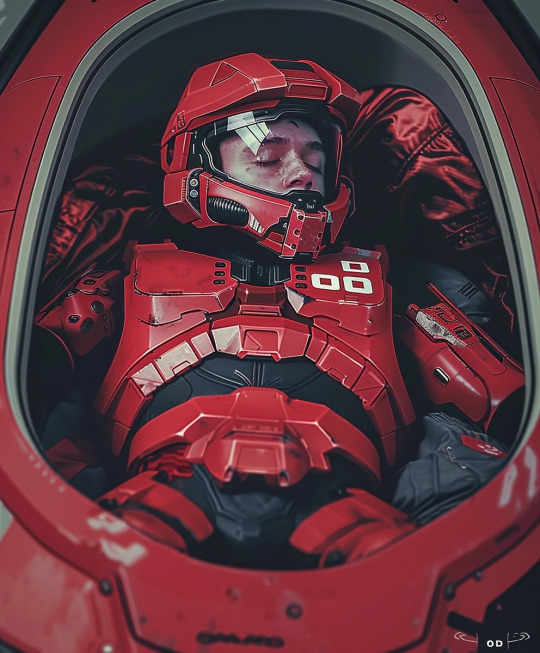
2 notes
·
View notes
Text
Shop Testo: Your Destination for Premium Measuring and Monitoring Solutions
Looking for reliable and innovative measuring equipment? Visit Shop Testo, the ultimate hub for professional measuring devices. Catering to industries such as food safety, pharmaceuticals, HVAC, and more, Shop Testo offers a wide range of tools designed to ensure precision and compliance.
At Shop Testo, you’ll find the equipements that simplify complex tasks. Our selection of temperature monitoring devices includes advanced systems like WiFi-enabled loggers, cloud-based monitoring tools, and high-accuracy thermometers. These devices help to maintain optimal conditions for storage and production, making them essential for businesses that prioritize quality and safety.
For those seeking professional measuring devices, Shop Testo provides a diverse range of instruments tailored to various applications. From humidity meters and air velocity testers to CO2 monitors and data loggers, our devices are designed for precision, durability, and ease of use. Each product meets the highest industry standards, ensuring you have the right tools for your professional needs.

What sets Shop Testo apart is our commitment to customer satisfaction. With detailed product descriptions, user-friendly interfaces, and expert support, we make it easy for you to select the best tools for your operations. Plus, our fast and secure online shopping experience ensures you get the equipment you need, when you need it.
Whether you’re a food safety professional, an HVAC technician, or a laboratory specialist, Shop Testo is the ideal solution for you. Explore our wide range of professional measuring devices to optimize your workflow, enhance accuracy, and maintain compliance with industry regulations.
#Professional measuring devices#Testo measuring instruments#Environmental monitoring devices#Temperature monitoring devices#Humidity monitoring solutions#Food safety measuring tools#Data loggers for industrial use
0 notes
Text

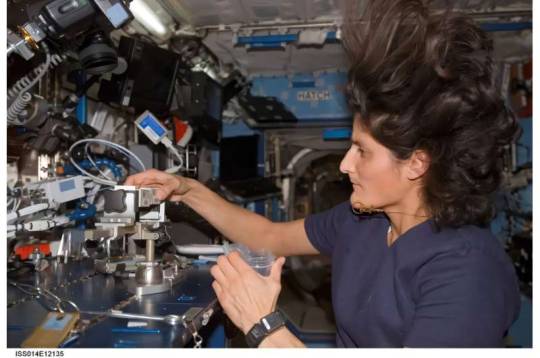

Wearable tech for space station research
Many of us wear devices that count our steps, measure our heart rate, track sleep patterns, and more. This information can help us make healthy decisions—research shows the devices encourage people to move more, for example—and could flag possible problems, such as an irregular heartbeat.
Wearable monitors also have become common tools for research on human health, including studies on the International Space Station. Astronauts have worn special watches, headbands, vests, and other devices to help scientists examine sleep quality, effectiveness of exercise, heart health, and more.
Warm to the core
Spaceflight can affect body temperature regulation and daily rhythms due to factors such as the absence of convection (a natural process that transfers heat away from the body) and changes in the cardiovascular and metabolic systems.
A current investigation from ESA (European Space Agency), Thermo-Mini or T-Mini examines how the body regulates its core temperature during spaceflight. The study uses a non-invasive headband monitor that astronauts can wear for hours at a time.
Data from the monitor allow researchers to determine the effect on body temperature from environmental and physiological factors such as room temperature and humidity, time of day, and physical stress. The same type of sensor is already used on Earth for research in clinical environments, such as improving incubators, and studies of how hotter environments affect human health.
Thermolab, an earlier ESA investigation, examined thermoregulatory and cardiovascular adaptations during rest and exercise in microgravity. Researchers found that core body temperature rises higher and faster during exercise in space than on Earth and that the increase was sustained during rest, a phenomenon that could affect the health of crew members on long-term spaceflight.
The finding also raises questions about the thermoregulatory set point humans are assumed to have as well as our ability to adapt to climate change on Earth.
To sleep, perchance to dream
Spaceflight is known to disrupt sleep-wake patterns. Actiwatch Spectrum, a device worn on the wrist, contains an accelerometer to measure motion and photodetectors to monitor ambient lighting. It is an upgrade of previous technology used on the space station to monitor the length and quality of crew member sleep.
Data from earlier missions show that crew members slept significantly less during spaceflight than before and after. The Actiwatch Sleep-Long investigation used an earlier version of the device to examine how ambient light affects the sleep-wake cycle and found an association between sleep deficiency and changes during spaceflight in circadian patterns, or the body's response to a normal 24-hour light and dark cycle.
Follow-up studies are testing lighting systems to address these effects and help astronauts maintain healthy circadian rhythms.
Wearable Monitoring tested a lightweight vest with embedded sensors to monitor heart rate and breathing patterns during sleep and help determine whether changes in heart activity affect sleep quality. The technology offers a significant advantage by monitoring heart activity without waking the test subject and could help patients on Earth with sleep disorders.
Researchers reported positive performance and good quality of recorded signals, suggesting that the vest can contribute to comprehensive monitoring of individual health on future spaceflight and in some settings on Earth as well.
These and other studies support development of countermeasures to improve sleep for crew members, helping to maintain alertness and lessen fatigue during missions.
(Not) waiting to exhale
Humans exhale carbon dioxide and too much of it can build up in closed environments, causing headaches, dizziness, and other symptoms. Spacecraft have systems to remove this substance from cabin air, but pockets of carbon dioxide can form and be difficult to detect and remove.
Personal CO2 Monitor tested specially designed sensors attached to clothing to monitor the wearer's immediate surroundings. Researchers reported that the devices functioned adequately as either crew-worn or static monitors, an important step toward using them to determine how carbon dioxide behaves in enclosed systems like spacecraft.
Radiation in real time
EVARM, an investigation from CSA (Canadian Space Agency), used small wireless dosimeters carried in a pocket to measure radiation exposure during spacewalks. The data showed that this method is a feasible way to measure radiation exposure, which could help focus routine dosage monitoring where it is most needed. Any shielding and countermeasures developed also could help protect people who work in high-radiation areas on Earth.
ESA's Active Dosimeter tested a radiation dosimeter worn by crew members to measure changes in their exposure over time based on the space station's orbit and altitude, the solar cycle, and solar flares. Measurements from the device allowed researchers to analyze radiation dosage across an entire space mission.
The Active Dosimeter also was among the instruments used to measure radiation on NASA's Orion spacecraft during its 25.5-day uncrewed Artemis I mission around the moon and back in 2022.
Another device tested on the space station and then on Artemis I, AstroRad Vest is designed to protect astronauts from solar particle events. Researchers used these and other radiation measuring devices to show that Orion's design can protect its crew from potentially hazardous radiation levels during lunar missions.
The International Space Station serves as an important testbed for these technologies and many others being developed for future missions to the moon and beyond.
TOP IMAGE: NASA astronaut Nick Hague wears the T-mini device while exercising. Credit: NASA
CENTRE IMAGE: NASA astronaut Sunita Williams wears an Actiwatch as she conducts research. Credit: NASA
LOWER IMAGE: ESA astronaut Thomas Pesquet holds one of the mobile units for the Active Dosimeter study. Credit: NASA
2 notes
·
View notes
Text
Interactive mouthpiece opens new opportunities for health data, assistive technology, and hands-free interactions
New Post has been published on https://thedigitalinsider.com/interactive-mouthpiece-opens-new-opportunities-for-health-data-assistive-technology-and-hands-free-interactions/
Interactive mouthpiece opens new opportunities for health data, assistive technology, and hands-free interactions
When you think about hands-free devices, you might picture Alexa and other voice-activated in-home assistants, Bluetooth earpieces, or asking Siri to make a phone call in your car. You might not imagine using your mouth to communicate with other devices like a computer or a phone remotely.
Thinking outside the box, MIT Computer Science and Artificial Intelligence Laboratory (CSAIL) and Aarhus University researchers have now engineered “MouthIO,” a dental brace that can be fabricated with sensors and feedback components to capture in-mouth interactions and data. This interactive wearable could eventually assist dentists and other doctors with collecting health data and help motor-impaired individuals interact with a phone, computer, or fitness tracker using their mouths.
Resembling an electronic retainer, MouthIO is a see-through brace that fits the specifications of your upper or lower set of teeth from a scan. The researchers created a plugin for the modeling software Blender to help users tailor the device to fit a dental scan, where you can then 3D print your design in dental resin. This computer-aided design tool allows users to digitally customize a panel (called PCB housing) on the side to integrate electronic components like batteries, sensors (including detectors for temperature and acceleration, as well as tongue-touch sensors), and actuators (like vibration motors and LEDs for feedback). You can also place small electronics outside of the PCB housing on individual teeth.
Play video
MouthIO: Fabricating Customizable Oral User Interfaces with Integrated Sensing and Actuation Video: MIT CSAIL
The active mouth
“The mouth is a really interesting place for an interactive wearable and can open up many opportunities, but has remained largely unexplored due to its complexity,” says senior author Michael Wessely, a former CSAIL postdoc and senior author on a paper about MouthIO who is now an assistant professor at Aarhus University. “This compact, humid environment has elaborate geometries, making it hard to build a wearable interface to place inside. With MouthIO, though, we’ve developed a new kind of device that’s comfortable, safe, and almost invisible to others. Dentists and other doctors are eager about MouthIO for its potential to provide new health insights, tracking things like teeth grinding and potentially bacteria in your saliva.”
The excitement for MouthIO’s potential in health monitoring stems from initial experiments. The team found that their device could track bruxism (the habit of grinding teeth) by embedding an accelerometer within the brace to track jaw movements. When attached to the lower set of teeth, MouthIO detected when users grind and bite, with the data charted to show how often users did each.
Wessely and his colleagues’ customizable brace could one day help users with motor impairments, too. The team connected small touchpads to MouthIO, helping detect when a user’s tongue taps their teeth. These interactions could be sent via Bluetooth to scroll across a webpage, for example, allowing the tongue to act as a “third hand” to open up a new avenue for hands-free interaction.
“MouthIO is a great example how miniature electronics now allow us to integrate sensing into a broad range of everyday interactions,” says study co-author Stefanie Mueller, the TIBCO Career Development Associate Professor in the MIT departments of Electrical Engineering and Computer Science and Mechanical Engineering and leader of the HCI Engineering Group at CSAIL. “I’m especially excited about the potential to help improve accessibility and track potential health issues among users.”
Molding and making MouthIO
To get a 3D model of your teeth, you can first create a physical impression and fill it with plaster. You can then scan your mold with a mobile app like Polycam and upload that to Blender. Using the researchers’ plugin within this program, you can clean up your dental scan to outline a precise brace design. Finally, you 3D print your digital creation in clear dental resin, where the electronic components can then be soldered on. Users can create a standard brace that covers their teeth, or opt for an “open-bite” design within their Blender plugin. The latter fits more like open-finger gloves, exposing the tips of your teeth, which helps users avoid lisping and talk naturally.
This “do it yourself” method costs roughly $15 to produce and takes two hours to be 3D-printed. MouthIO can also be fabricated with a more expensive, professional-level teeth scanner similar to what dentists and orthodontists use, which is faster and less labor-intensive.
Compared to its closed counterpart, which fully covers your teeth, the researchers view the open-bite design as a more comfortable option. The team preferred to use it for beverage monitoring experiments, where they fabricated a brace capable of alerting users when a drink was too hot. This iteration of MouthIO had a temperature sensor and a monitor embedded within the PCB housing that vibrated when a drink exceeded 65 degrees Celsius (or 149 degrees Fahrenheit). This could help individuals with mouth numbness better understand what they’re consuming.
In a user study, participants also preferred the open-bite version of MouthIO. “We found that our device could be suitable for everyday use in the future,” says study lead author and Aarhus University PhD student Yijing Jiang. “Since the tongue can touch the front teeth in our open-bite design, users don’t have a lisp. This made users feel more comfortable wearing the device during extended periods with breaks, similar to how people use retainers.”
The team’s initial findings indicate that MouthIO is a cost-effective, accessible, and customizable interface, and the team is working on a more long-term study to evaluate its viability further. They’re looking to improve its design, including experimenting with more flexible materials, and placing it in other parts of the mouth, like the cheek and the palate. Among these ideas, the researchers have already prototyped two new designs for MouthIO: a single-sided brace for even higher comfort when wearing MouthIO while also being fully invisible to others, and another fully capable of wireless charging and communication.
Jiang, Mueller, and Wessely’s co-authors include PhD student Julia Kleinau, master’s student Till Max Eckroth, and associate professor Eve Hoggan, all of Aarhus University. Their work was supported by a Novo Nordisk Foundation grant and was presented at ACM’s Symposium on User Interface Software and Technology.
#3-D printing#3d#3D model#Accessibility#alexa#app#artificial#Artificial Intelligence#Assistive technology#author#Bacteria#batteries#bluetooth#box#Capture#career#career development#communication#complexity#computer#Computer Science#Computer Science and Artificial Intelligence Laboratory (CSAIL)#Computer science and technology#data#dental#Design#development#devices#do it yourself#Electrical engineering and computer science (EECS)
2 notes
·
View notes
Text
I am a doll collector with BJD and buying parts or making hybrids can be a pain to color match. Just like playline dolls there’s not much consistency between brands. Some resins age differently, too.
The most reliable color matching source would probably be something like Pantone color cards, but those are FREAKING EXPENSIVE and it’s not reasonable to expect everyone to have them.
BJD collecting is an expensive luxury hobby and there are some of us that do need to keep our spending as minimal as possible.
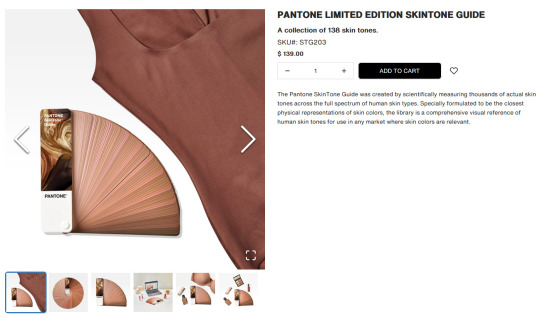
This skintone chips set (https://www.pantone.com/products/fashion-home-interiors/skintone-guide-limited-edition) has an excellent range of skin tones, but seems to be lacking the pasty pale practically white colors a lot of Asian BJD come in and costs as much as a lower-priced BJD.
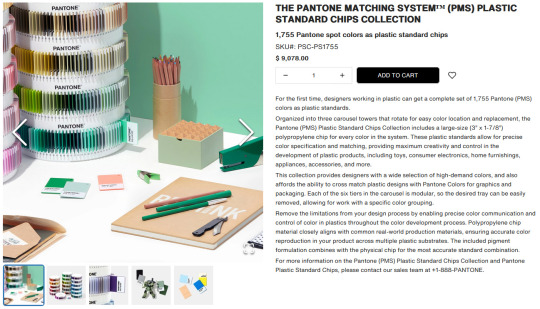
This set (https://www.pantone.com/products/plastics/the-pantone-matching-system-plastic-standard-chips-collection) seems ideal for color matching plastics, which resin is, at first but it’s polypropylene chips which will degrade in a few years, and not all colors of urethane or epoxy resins can be replicated in polypropylene. It’s also NINE THOUSAND FREAKING DOLLARS.
We all know I’m always looking for something functional and accessible and $9k that’s going to discolor and maybe even crumble in a decade is not my idea of accessible.
-
@maleficentmrsofallevil suggested a digital resource (https://redketchup.io/color-picker) which is free and accessible to most collectors that have an internet connection and using HEX codes is consistent across devices, however there are a few problems that we might run into.
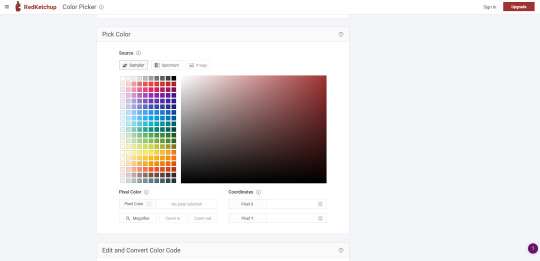
Everyone’s monitors/phone screens and cameras would have to be calibrated exactly the same, and everyone’s lighting when making comparisons would have to be identical for this to be a viable resource. The hex chart being backlit could also skew the way it looks compared to a tangible resin sample.
That’s frustrating. Free and easy for most people to get a hold of is the ideal.
The main benefit of a physical vs digital resource for color matching is that the color sample and the doll are both subjected to the same lighting conditions, monitor settings, and camera settings so even if those factors vary between users, the comparison will still be relatively accurate.
-
A bunch of us sat around discussing different options. International hobby paint brands like Vallejo or Mr. Color, international makeup foundation color cards, etc. etc.
I’ve decided to give DMC embroidery floss color cards a try.

There are two versions.
One has samples of the actual floss in the book and costs about $40.
https://amzn.to/3Oq8G2f
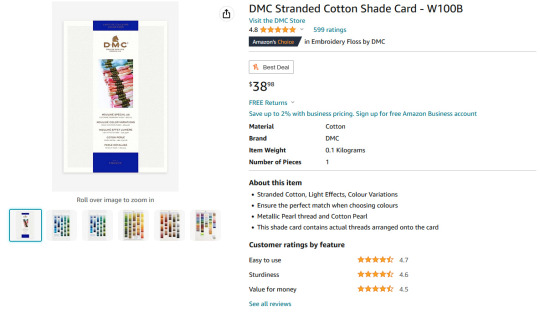
The other has printed color blocks that presumably match the floss colors and costs about $10.
https://amzn.to/3Q2H8Bb

DMC are sticklers for their colors being the same across dye lots. Sometimes they change the numbers on colors and sometimes they discontinue colors all together, so we do still run into the issue of whether everyone’s looking at the same color cards or different versions.
At $10, needing to replace or update the color card every few years isn’t nearly as daunting as a $9k plastic samples set falling apart in your hands once a decade.
(Can you tell I hate polypropylene when used in conjunction with dolls?)
Other variables that will affect the efficacy of using DMC color cards are the conditions under which the color cards are kept like sun exposure, temperature, humidity etc. affecting either the color of the thread samples or the quality of the printed samples.
Another factor is consistency between printed samples.
I have not received these, yet, but my plan is to first compare them to each other to see how well the printed samples match the swatched samples, and then proceed from there.
21 notes
·
View notes